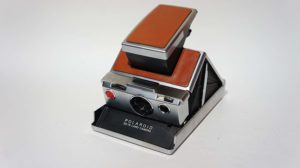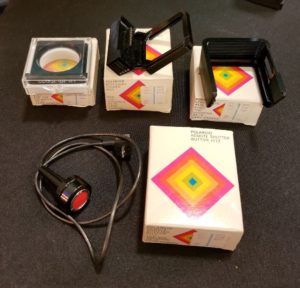
1972 was a banner year for inventiveness, consumer-product-wise. That year, Mr. Coffee was born. The coffeemaker, which forever changed the way the morning brew was prepared, will no doubt rate its own future mention here.
The other big release that year was the Polaroid SX-70.
Polaroid had long ago made its name with instant photography. They released their first peel-and-see camera in 1948, just in time for our fathers, getting more prosperous by the day, to preserve images of their lovely kids (that would be US!). By 1965, they released the affordable Swinger, which many Boomers made their first camera purchase.
But let’s face it: peeling off the top layer after exactly the right number of seconds was, well, a pain. While still preferable to waiting days for pictures to get developed, we tired of having to carry waste disposal means with us wherever we went. And that emulsion was seriously nasty, sticky stuff if you happened to touch it.
Thus, the world was overjoyed when the SX-70 was released, a camera that spit out a picture that would magically develop right before your very eyes! And no nasty paper to throw away!
The SX-70 was a true SLR, i.e. you viewed the subject through the same lens that would record its image. This was sophisticated stuff for our parents, who might have owned Kodak Brownies that had primitive viewfinders that had to be used by looking down at the top of the camera. This feature was previously only available on expensive Hasselblads, Nikons, and the like.
Not only that, but its design was amazing. Polaroid had long produced cameras that would fold down to a smaller size for transportation between shots, but they went the extra mile with the SX-70.
The camera would collapse in upon itself to form a small rectangular box that would fit in the smallest purse. It wasn’t quite pocket-sized, but was a lot of fun for a kid to open and close. Now it’s a camera, now it’s a little box.

It was a beautiful piece of art. Its metal was brushed chrome, it also featured genuine leather. Oh, and the camera had another groundbreaking feature: it focused itself! Though the initial model was a manually-focused device, it was soon released with sonar-activated auto-focus. Cool beans! Later on, Polaroid would sell the One-Step, which didn’t collapse and was made largely of plastic, to those of us who were financially challenged. That way we could enjoy the power of an autofocusing instant camera (albeit not an SLR) without the pain of the SX-70’s steep price.
Such a sophisticated instrument called for sophisticated accessories. Thus, you could purchase a telephoto adapter, a macro adapter, a self-timer, and external flashes (the original used a flash bar). It was possible to take some seriously detailed photos with the camera’s one-to-one ratio of image to film, though limited to 3.1 x 3.1 inches in size.
Experimenters soon learned that you could get quite artistic with SX-70 images. You could fold, spindle, and mutilate the prints into unique creations. Of course, you could also screw them up pretty good if you weren’t careful.
The SX-70 was a high flyer for the rest of the decade. The popularity of its more inexpensive instant cameras caused the company to discontinue the original SX-70 in 1981 (They also had instant-picture competition from Kodak, but squashed that with a victorious 1986 patent lawsuit). This was a cause of worry for its owners, as fear of no more film became a threat. However, Polaroid continued to manufacture SX-70 film until 2005. And even then, owners were able to hack their cameras to use 600 film. Unfortunately, Polaroid has ceased the manufacturing of all films for cameras of the 70’s and 80’s, but check out this SX-70 hack site, which shows that the inventive spirit of the camera’s fans will triumph over the mere lack of original accessories.
The digital camera revolution has forced camera companies to adapt or die. Kodak is doing great. Polaroid failed to change their business model in a timely manner. Hence, they have had a series of bankruptcies since 2001, but the company appears to still be going fairly strongly.Their website shows a diverse number of products, including digital cameras, “retro” film cameras, and some decidedly non-photographic items.
I hope they turn a profit. A world without the Polaroid brand name would be a little sadder. Any company cool enough to come up with the Swinger and the SX-70 deserves to survive.